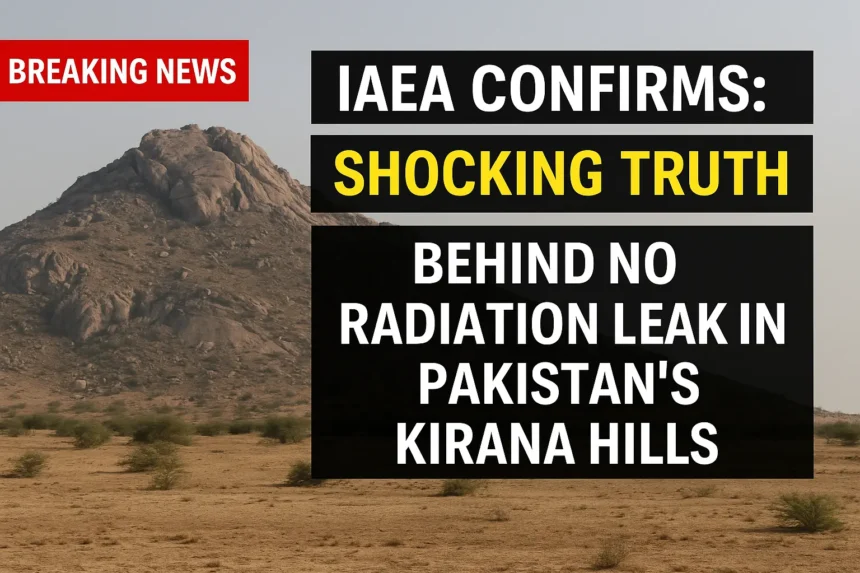IAEA Confirms: Shocking Truth Behind No Radiation Leak in Pakistan’s Kirana Hills
A Viral Rumor, A Global Panic—And Then, the Truth
In recent days, rumors swirled across social media platforms and some international news sites, claiming that Indian airstrikes had struck a nuclear facility in Pakistan’s Kirana Hills. Speculation intensified with reports of a potential radiation leak, and the world watched anxiously. But now, the International Atomic Energy Agency (IAEA) has stepped in with an authoritative statement that puts these fears to rest: there was no radiation leak in Pakistan.
So, what really happened? How did such a serious rumor gain traction, and why did it take the IAEA to calm the global conversation? Let’s break it down.
What Sparked the Nuclear Leak Rumor?
The rumors began soon after Operation Sindoor, a military operation reportedly conducted by India in response to escalating border tensions. Soon after, speculative reports emerged claiming India had hit Kirana Hills—an area in Sargodha, Pakistan, widely believed to be home to underground nuclear tunnels and part of Pakistan’s strategic military infrastructure.
Social media platforms lit up with mentions of radiation leaks, nuclear war fears, and geopolitical crises. Some even cited flight tracking data of a U.S. Department of Energy aircraft—known for responding to nuclear emergencies like Fukushima—operating near Pakistani airspace. Another unverified claim suggested an Egyptian military plane had landed in Pakistan carrying boron, a chemical used to control radioactive leaks.
IAEA’s Firm Clarification Ends Speculation
In an official email response to The Times of India, Fredrik Dahl from the IAEA press office said,
We are aware of the reports. Based on information available to the IAEA, there was no radiation leak or release from any nuclear facility in Pakistan.
This single statement from the world’s top nuclear authority cut through the noise, confirming there was no nuclear incident in Pakistan.
India’s Official Stand: “We Didn’t Hit Kirana Hills”
As speculation mounted, India was quick to issue formal clarifications.
Air Marshal A K Bharti, Director General of Air Operations, stated:
Thank you for telling us that Kirana Hills houses nuclear installations. We didn’t know about it. We have not hit Kirana Hills and whatever is there.
This subtly sarcastic yet firm denial was backed by India’s Ministry of External Affairs (MEA). Randhir Jaiswal, MEA spokesperson, said:
Our military action was entirely within the conventional domain.
He also dismissed speculative media reports about Pakistan’s National Command Authority convening an emergency meeting, saying those reports were equally baseless.
Pakistan Denies Radiation Leak and Military Crisis
Pakistan, too, responded swiftly. Government representatives and military officials denied any radiation incident or damage to nuclear infrastructure.
There were no official emergency protocols enacted, no press conferences about containment, and no announcements about nuclear safety drills—actions that would usually follow a real radiation event.
So, if all key parties—India, Pakistan, and the IAEA—have denied the incident, where did these theories come from?
Anatomy of a Misinformation Storm
Much of the chaos can be traced back to open-source flight tracking platforms. Online observers noted the appearance of certain aircraft near Pakistan that are typically associated with nuclear incident responses. But aviation experts and former military officials quickly debunked these theories, calling them “coincidental movements” and “misread data.”
Meanwhile, international media channels gave air time to analysts who speculated on “credible signs of a radiation event.” Some even claimed it was the real reason behind the ceasefire agreement between India and Pakistan.
The reality? These were just unverified rumors, amplified in the absence of official information—until the IAEA stepped in.
Kirana Hills: The Strategic Vault
Here’s a quick breakdown of why Kirana Hills holds such strategic importance:
| Location | Approximately 75 km from the Khushab nuclear complex |
| Military Significance | Believed to house over ten underground nuclear tunnels |
| Strategic Role | Key component in Pakistan’s second-strike nuclear capability |
| Security Level | Highly classified and heavily guarded facility |
| Public Claims | No verified evidence of any recent targeting or damage |
Why This Story Matters
False reports of a nuclear leak don’t just create panic—they can destabilize regional peace, damage diplomatic relations, and spark unintended escalation between nuclear-armed neighbors like India and Pakistan.
The spread of such misinformation shows how easy it is for speculation to go viral, especially when tied to high-stakes geopolitics and secretive military zones.
That’s why authoritative voices like the IAEA play a critical role in setting the record straight.
Final Word: Trust Facts, Not Fear
The dust has settled, and facts have emerged. There was no Indian strike on Kirana Hills, no nuclear leak, and no regional meltdown. The IAEA, India, and Pakistan have all confirmed that the situation is under control—and always was.
But this incident serves as a wake-up call about the power of misinformation in today’s digital world. For readers and news consumers, the best defense is to verify before sharing, trust credible sources, and avoid panic-driven narratives.
Most read: https://tnheadlines24.com/operation-sindoor-and-brahmos/
Also read: https://tnheadlines24.com/celebi-removed-from-delhi-airport/
Like This Story? Don’t Miss Out!
Stay updated on global security, geopolitics, and defense news that cuts through the noise. Subscribe to our newsletter and follow us for fact-checked reports that matter.
Was this article helpful? Share it with friends or drop a comment below.
Let’s make the internet a more informed place—together.
Most read: https://tnheadlines24.com/celebi-removed-from-delhi-airport/
Disclaimer: The information presented in this article is based on verified statements from official sources including the International Atomic Energy Agency (IAEA), Indian and Pakistani government representatives, and defense officials. All claims about nuclear incidents have been fact-checked against available data as of the time of publication.
TN HEADLINES24 is not affiliated with any government, defense, or international agency. This platform is committed to responsible journalism and does not promote misinformation or unverified claims. Readers are advised to rely on credible sources and avoid spreading unconfirmed reports.








